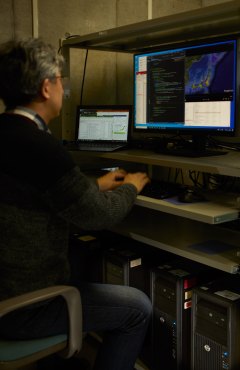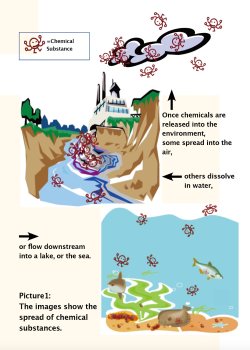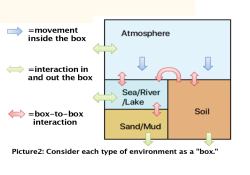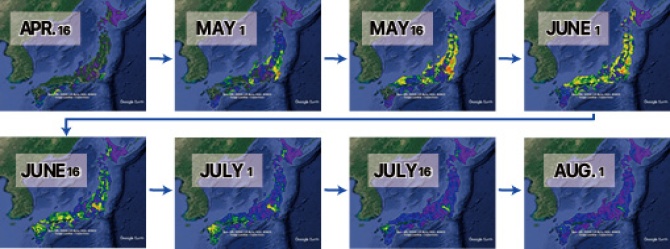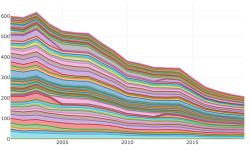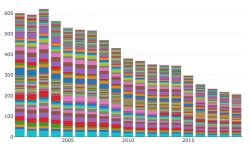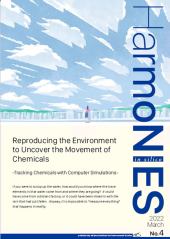HarmoNIES No.4
Reproducing the Environment to Uncover the Movement of Chemicals
the Movement of Chemicals
-Tracking Chemicals with Computer Simulations-
If you were to scoop up the water, how would you know where the trace elements in that water came from and where they are going? It could have come from a distant factory, or it could have been mixed in with the rain that had just fallen. Anyway, it is impossible to "measure everything" that happens in reality.
Keywords:Chemical substance, Environmental chemistry, Environmental modeling, Exposure assessment, G-CIEMS, Multimedia fate model
”In this process, we can, for example, simulate how the seasonal concentration of pesticides used in rice fields changes in rivers or understand the movement of radioactive materials from nuclear accidents.”
If you were to scoop up the water from a small river flowing in front of you with both hands, how would you know where the trace elements in that water came from and where they are going? You may be surprised that it takes a tremendous amount of detailed research to trace the movement exactly. A chemical could have come from a distant factory, or it could have been mixed in with rain that just fell. It might then flow downstream into a lake, accumulate on the river bottom, or be taken up by fish. In reality, it is impossible to measure everything that actually happens to chemicals in the environment.
Dr. Yoshitaka Imaizumi, who has been interested in programming since he was a student and fascinated with simulating ants gathering food in their nests, is now tracking chemical substances in the environment through computer simulations.
Chemicals—Good Companions, Hidden Disadvantages
But at times, some friends have a bad side. As you inhale, swallow, or touch them, they may cause headaches, eye pains, and sometimes even serious diseases, such as cancer, or they may even have negative effects on your genetics. If the chemicals are emitted into the environment, for example, in the air or water, they may spread and affect people, animals, and plants in different places, often far away from where the chemical was originally manufactured or used. This is a potential problem that we should take very seriously. We need to know where the chemicals are coming from and where they are going before any potential negative effects become irreversible.
Therefore, to protect people and the environment, Dr. Imaizumi is developing a method to simulate how chemical substances spread and become distributed in the environment.
Simulating the Movement of Chemicals
How can we know what chemicals are moving around in the environment? Chemicals are very small and, of course, not directly visible to the human eye. If they are dissolved in water or dispersed in the atmosphere, it is impossible to follow them visibly (Picture1). How then can we track them? To meet this challenge, Dr. Imaizumi uses computer models. With models like these, we can create a simulated environment on a computer and calculate the movement of chemical substances in that environment. In other words, he builds a "model environment" on the computer.
There are many different types of environments, including the atmosphere, oceans and rivers, soil, sand, and clay. Considering each as a “box”, we can calculate the movement of chemicals in and out of the box (Picture2). This is the basic concept underlying a model used for the entire environment (the model is called G-CIEMS). As the box becomes more detailed, we can expand the spatial extent of our calculations. By doing so, we can follow the movement of chemicals over a larger area and areas that have not even been surveyed. In this process, we can, for example, simulate how the seasonal concentration of pesticides used in rice fields changes in rivers or understand the movement of radioactive materials from nuclear accidents. That’s wonderful! However, each chemical varies in the ways they spread in the environment, it is important to design the “boxes” according to the natures of the chemical substances we want to learn about. It is also very important to select the environment to focus on, whether it is the entire environment, or a particular part of it, such as the atmosphere or a coastal area. Sometimes, to gain a more comprehensive understanding, we need to combine several of these factors in the model calculations.
The Future of Chemical Modeling Research
The total number of known chemical substances in use is already in the tens of thousands. And the list continues to grow as they are newly discovered in nature, intentionally created by humans, or unintentionally generated as byproducts. No one knows at this point if some of these chemicals that are now being used as our good friends will someday reveal as-yet unknown bad sides. In some cases, we can’t even tell which chemicals are causing negative effects. Dr. Imaizumi will continue his research gaining a better understanding of the total risk of a seemingly infinite number of chemicals.
Multimedia environmental fate model, G-CIEMS
Chemicals move through various media in the environment, such as the atmosphere, rivers, lakes, and soil. It is important to understand when, where, and how much of a substance is released into the environment. G-CIEMS(Grid-Catchment Integrated Environmental Modeling System) is a model based on GIS (Geographic Information System) data, this model estimates the concentration of a substance at each point and in each medium by simultaneously calculating both the transport between such multiple media and the transport within media such as the atmosphere and rivers (Picture 3).
Webkis-Plus (Chemical substance database)
Chemical substance database Webkis-Plus provides users to search for risk-related information and analysis methods for chemical substances listed in the Chemical Safety Information System and materials published by the Ministry of the Environment and other organizations. The information is listed by categories such as assessment/hazardousness and analytical methods, and then hierarchically divided into more detailed categories (Pictures 4 and 5).
URL:https://www.nies.go.jp/kisplus/
Related Papers
- Imaizumi, Y., Suzuki, N., Shiraishi, F., Nakajima, D., Serizawa, S., Sakurai, T., & Shiraishi, H. (2018). Development and validation of a simulation method, PeCHREM, for evaluating spatio-temporal concentration changes of paddy herbicides in rivers. Environmental science. Processes & impacts. https://doi.org/10.1039/c7em00517b
- Sakurai, T., Imaizumi, Y., Kuroda, K., Hayashi, T. I., & Suzuki, N. (2019). Georeferenced multimedia environmental fate of volatile methylsiloxanes modeled in the populous Tokyo Bay catchment basin. Sci Total Environ, 689, 843-853. https://doi.org/10.1016/j.scitotenv.2019.06.462
- Suzuki, N., Murasawa, K., Sakurai, T., Nansai, K., Matsuhashi, K., Moriguchi, Y., Tanabe, K., Nakasugi, O., & Morita, M. (2004). Geo-referenced multimedia environmental fate model (G-CIEMS): Model formulation and comparison to the generic model and monitoring approaches. Environmental Science & Technology, 38(21), 5682-5693. https://doi.org/10.1021/Es049261p
photography: Seiji Narita
Download PDF
Inquiry
International Coordination Office, Planning Division
National Institute for Environmental Studies
16-2 Onogawa, Tsukuba, Ibaraki 305-8506, Japan
e-mail: int-pub{a}nies.go.jp

